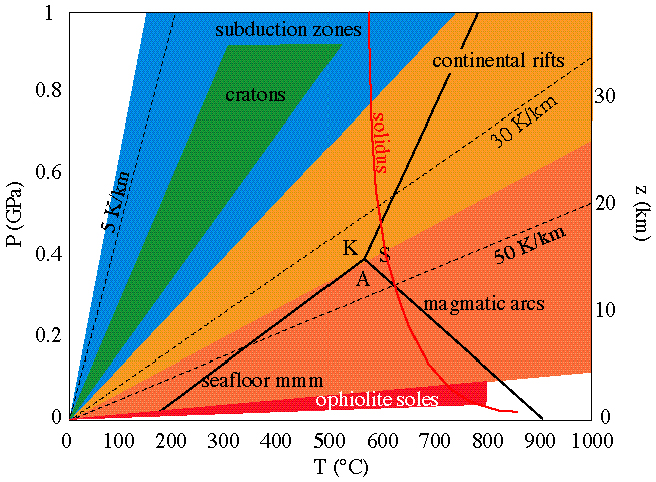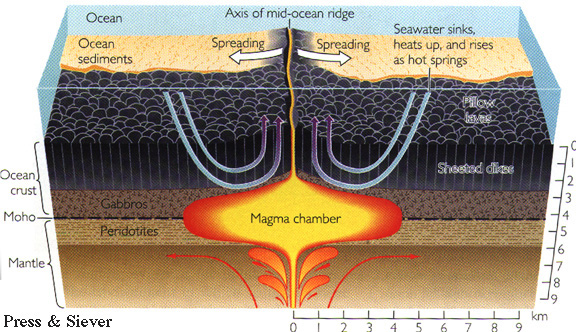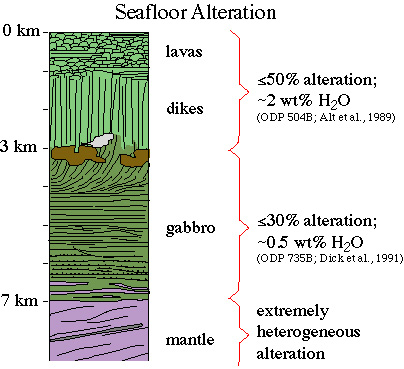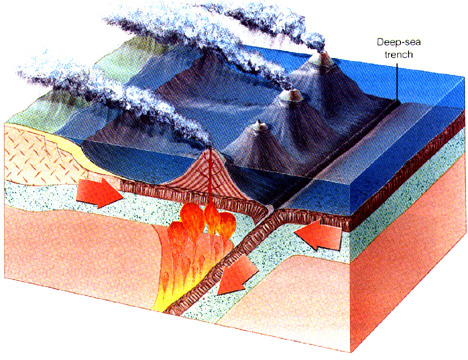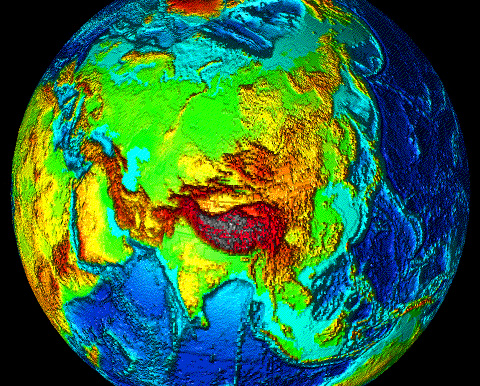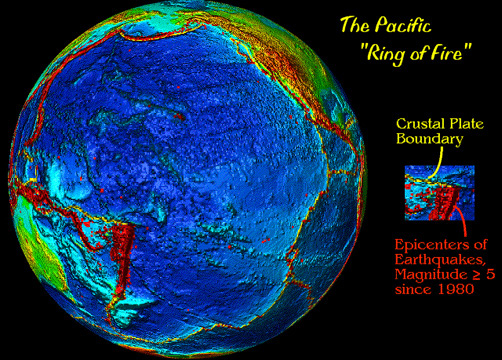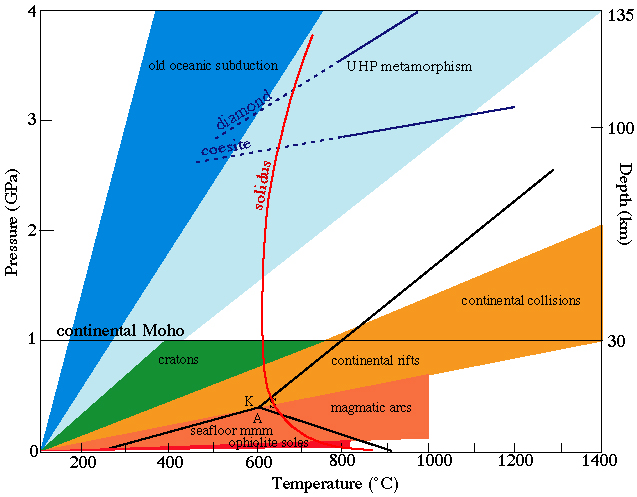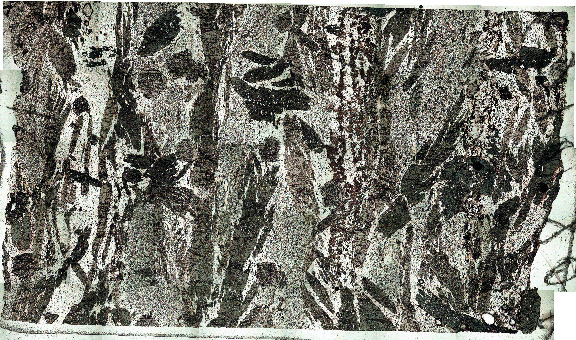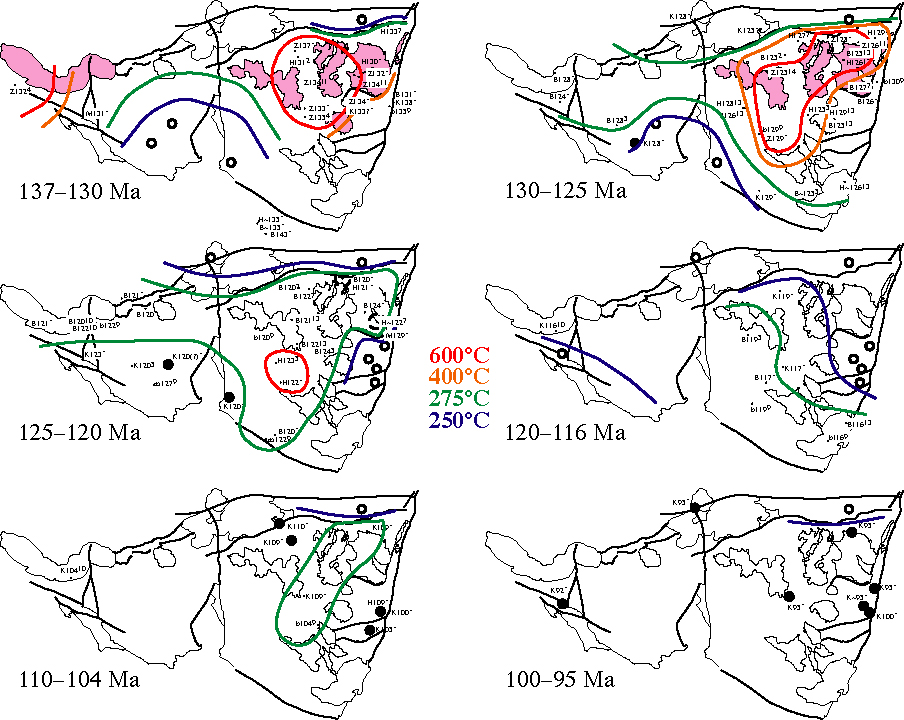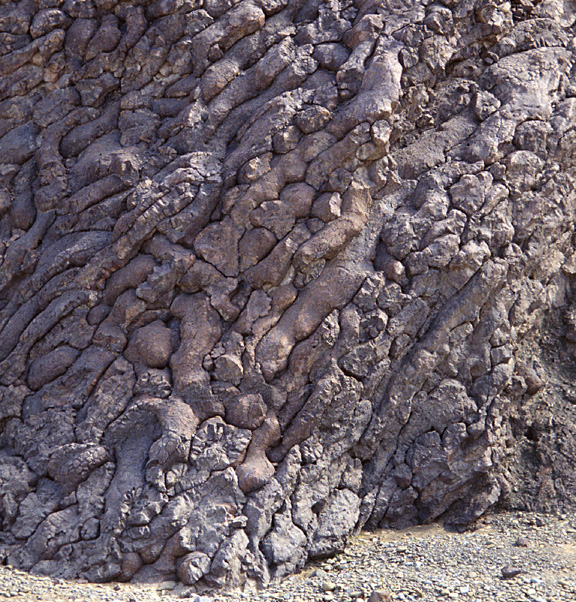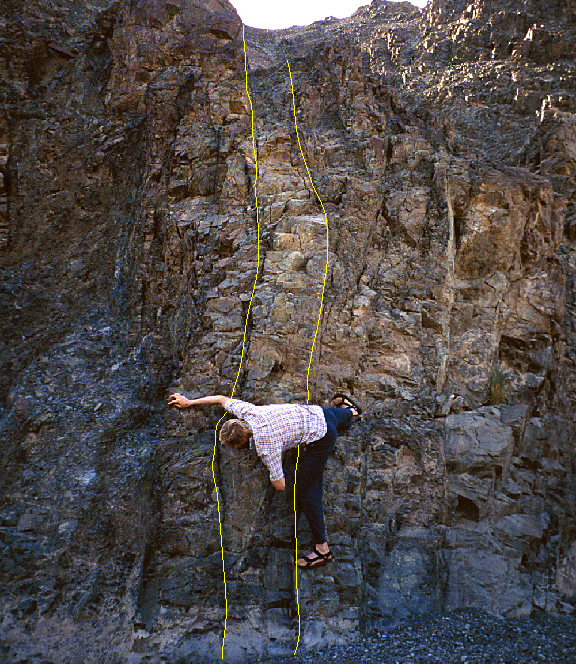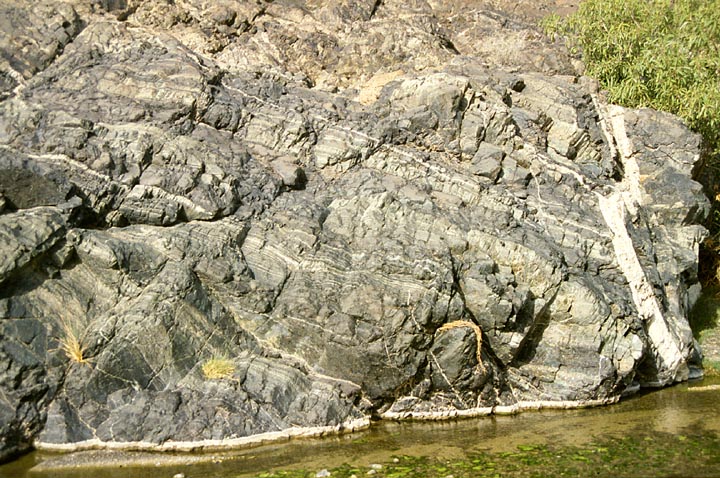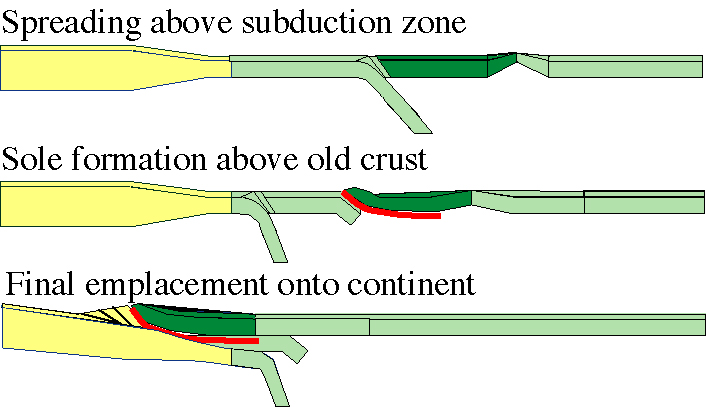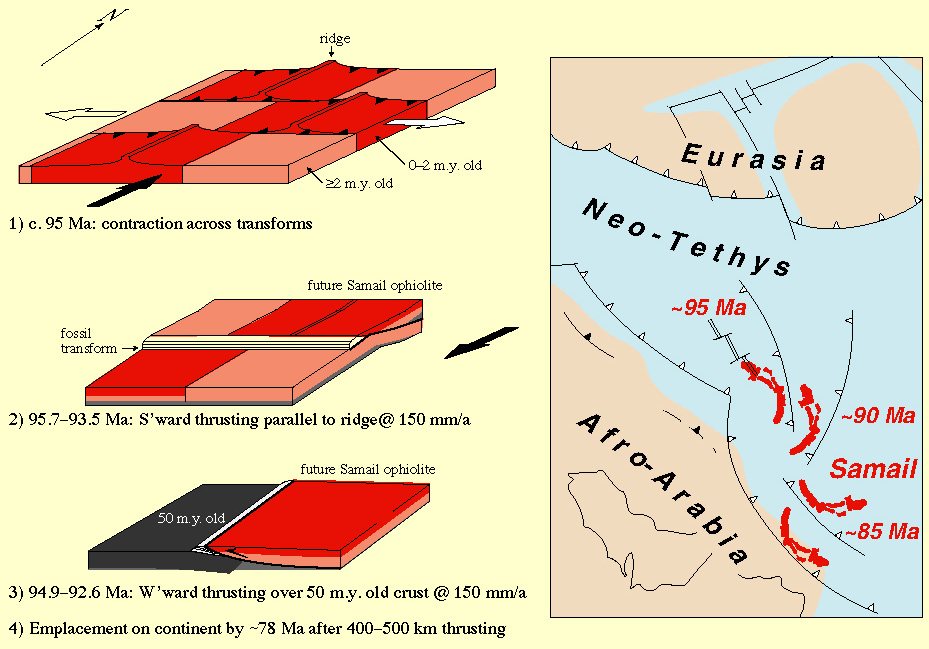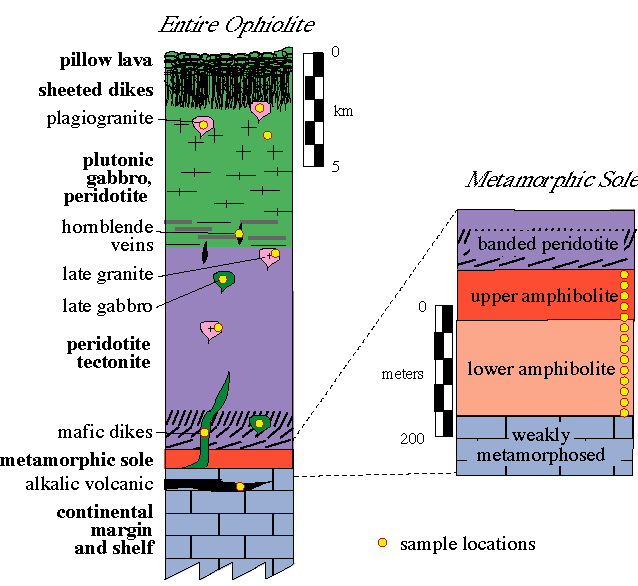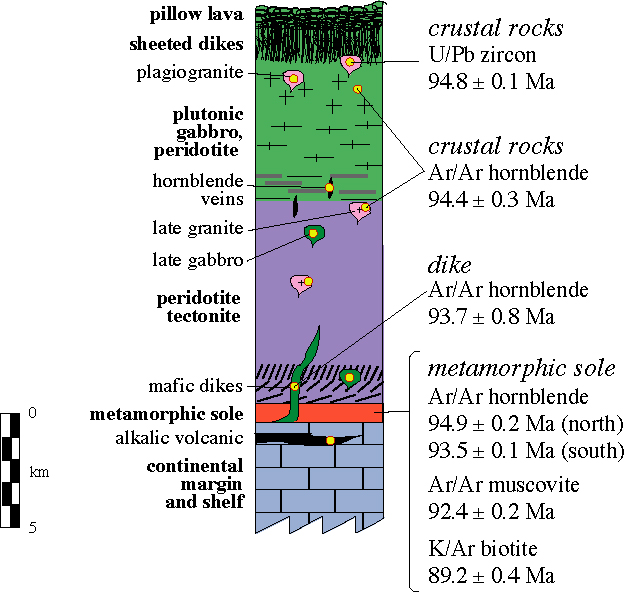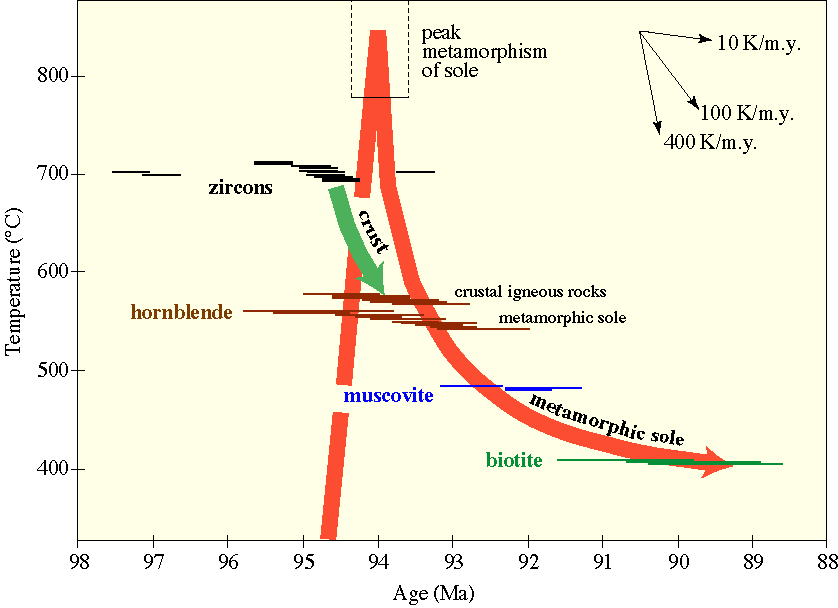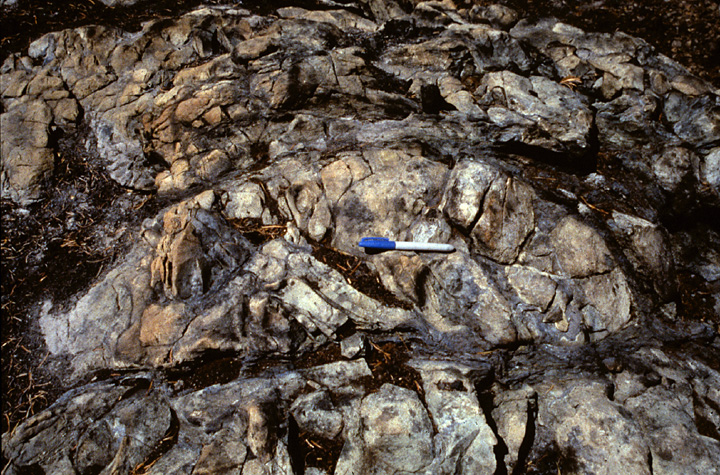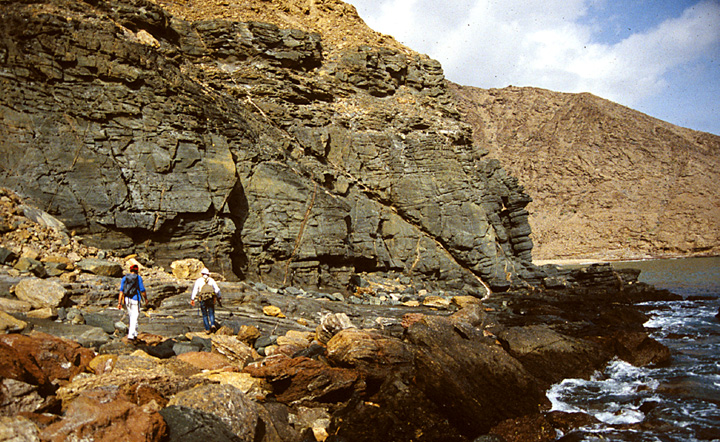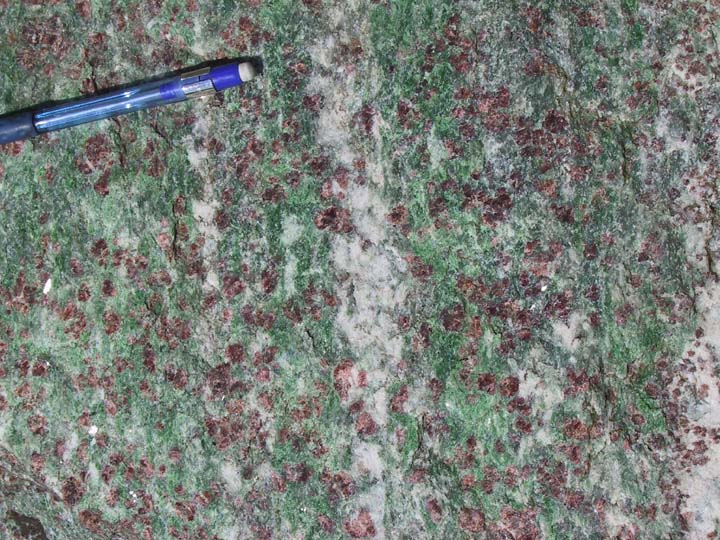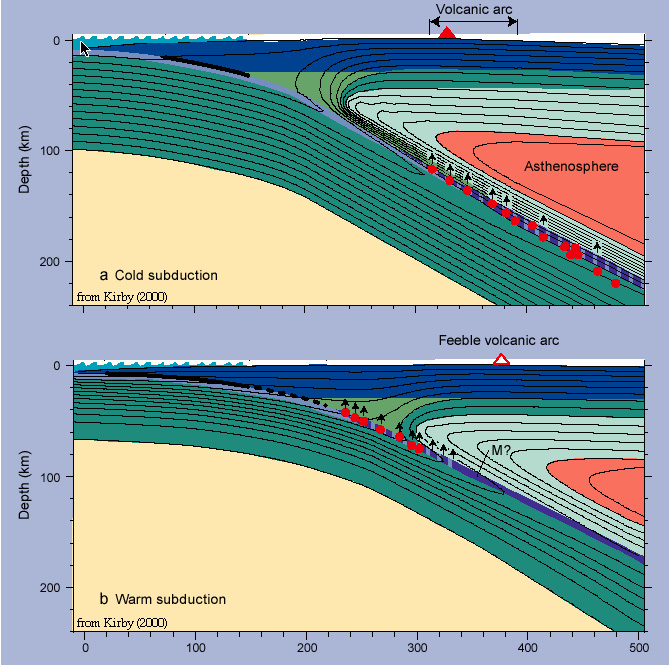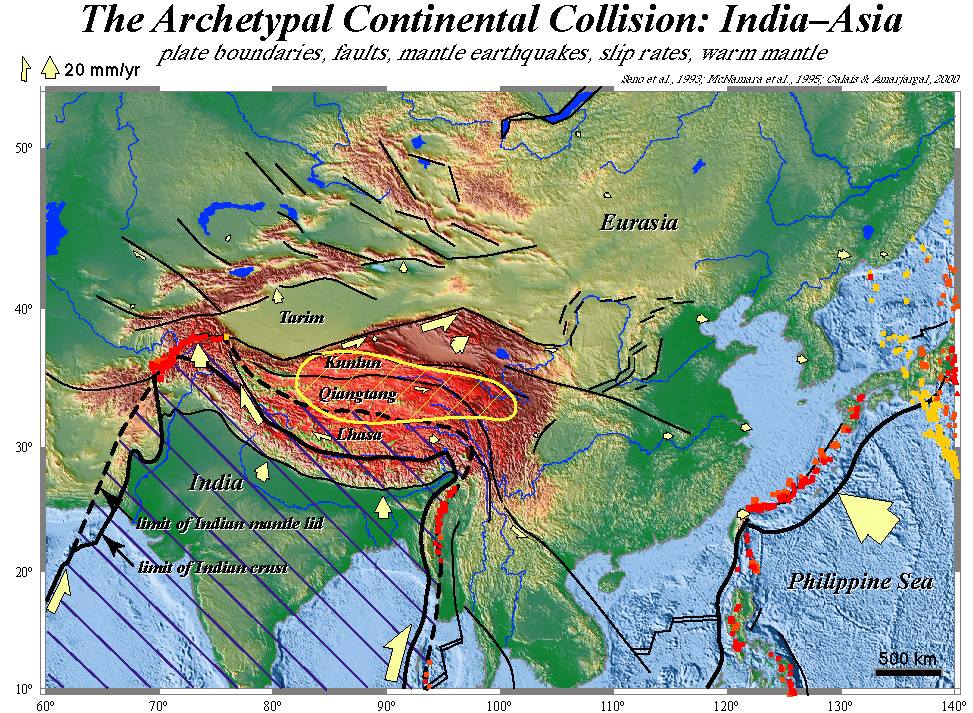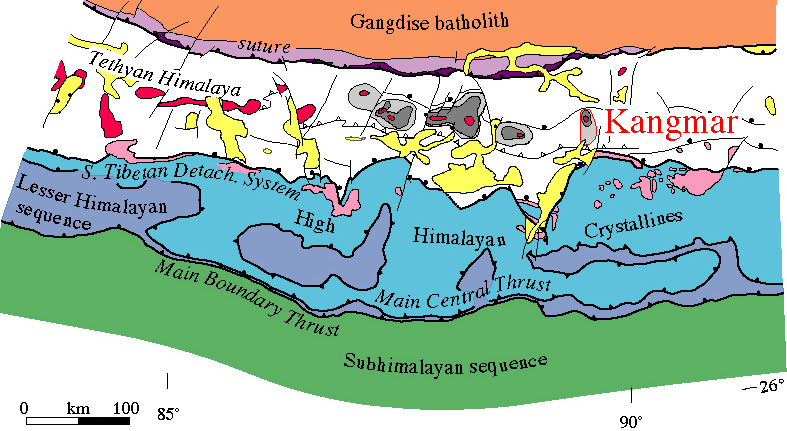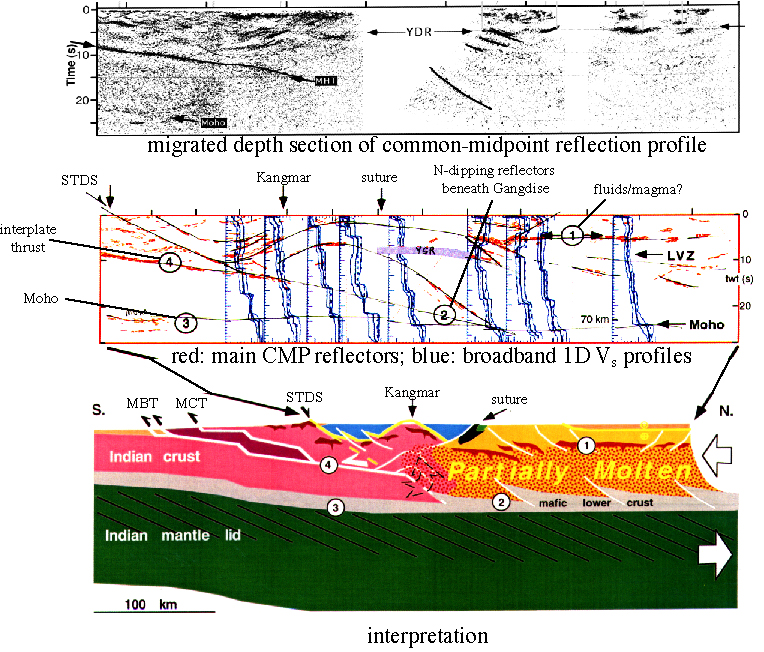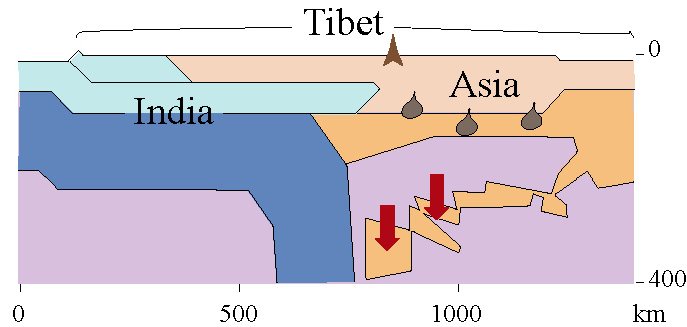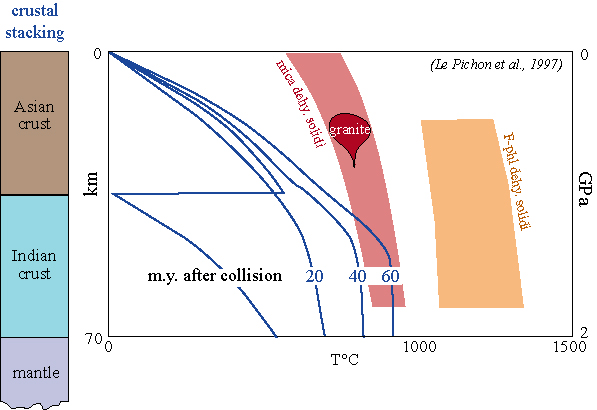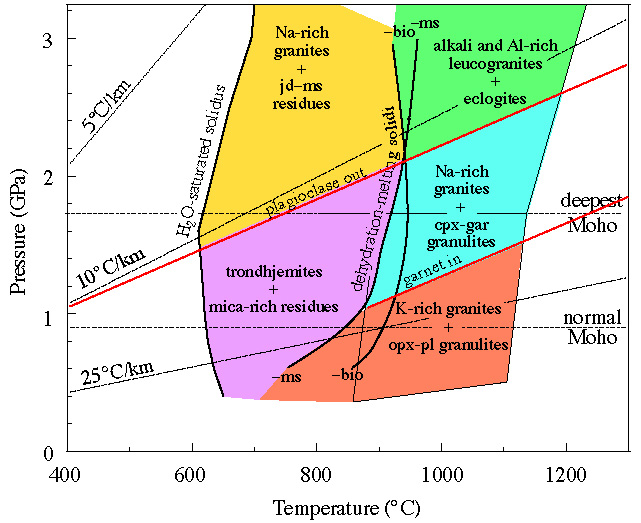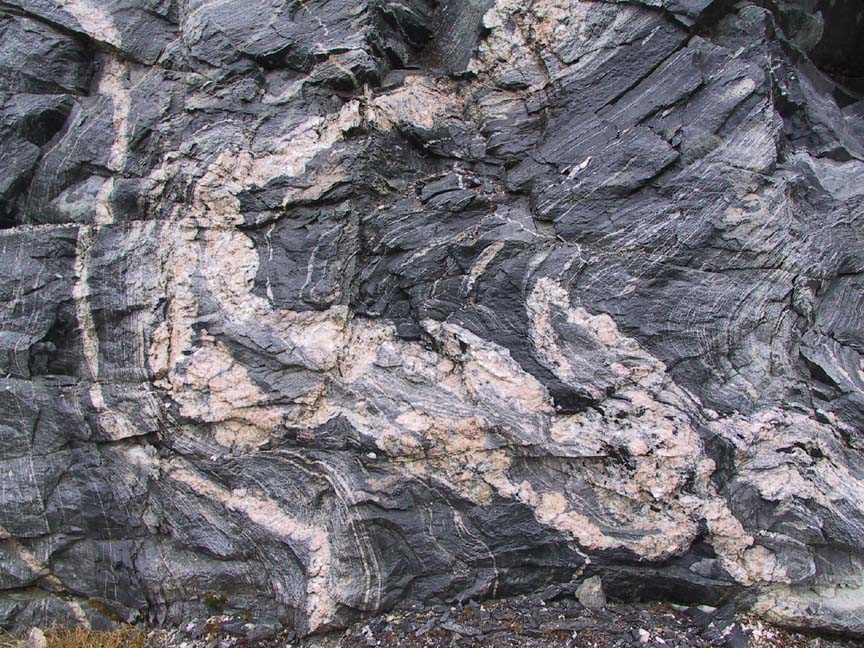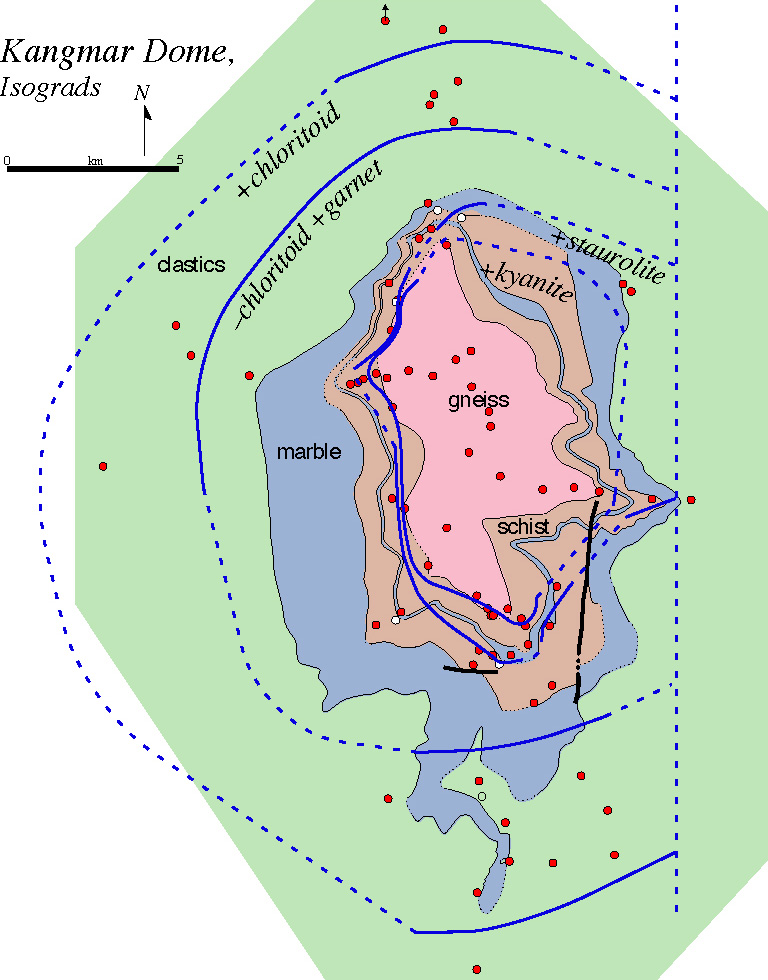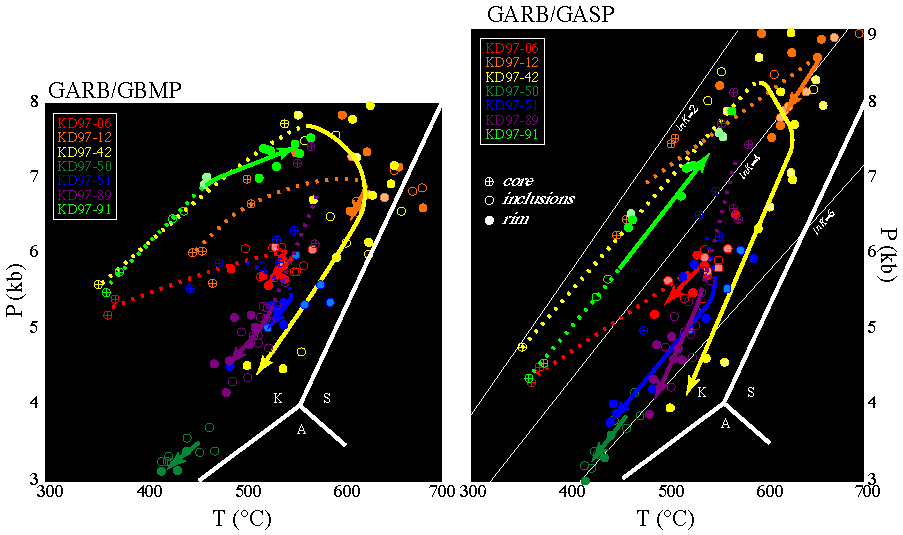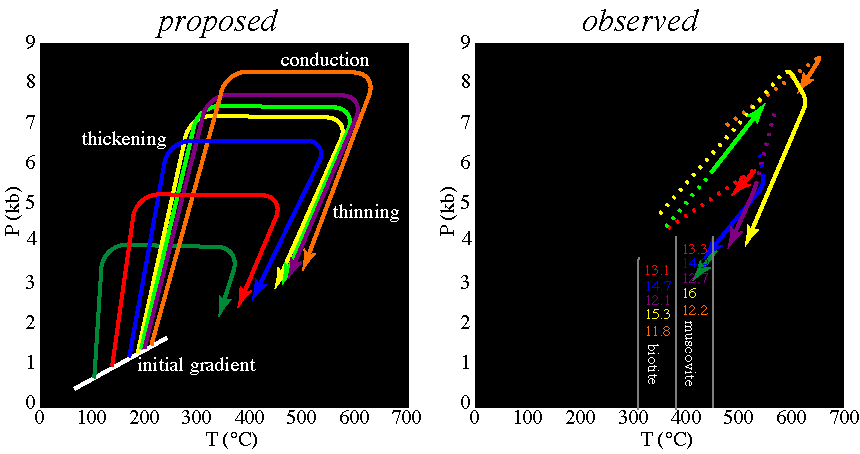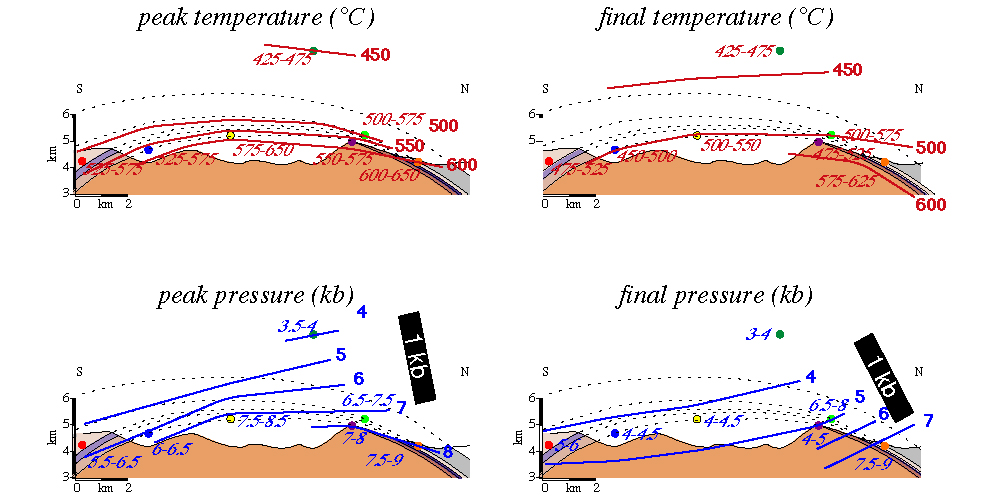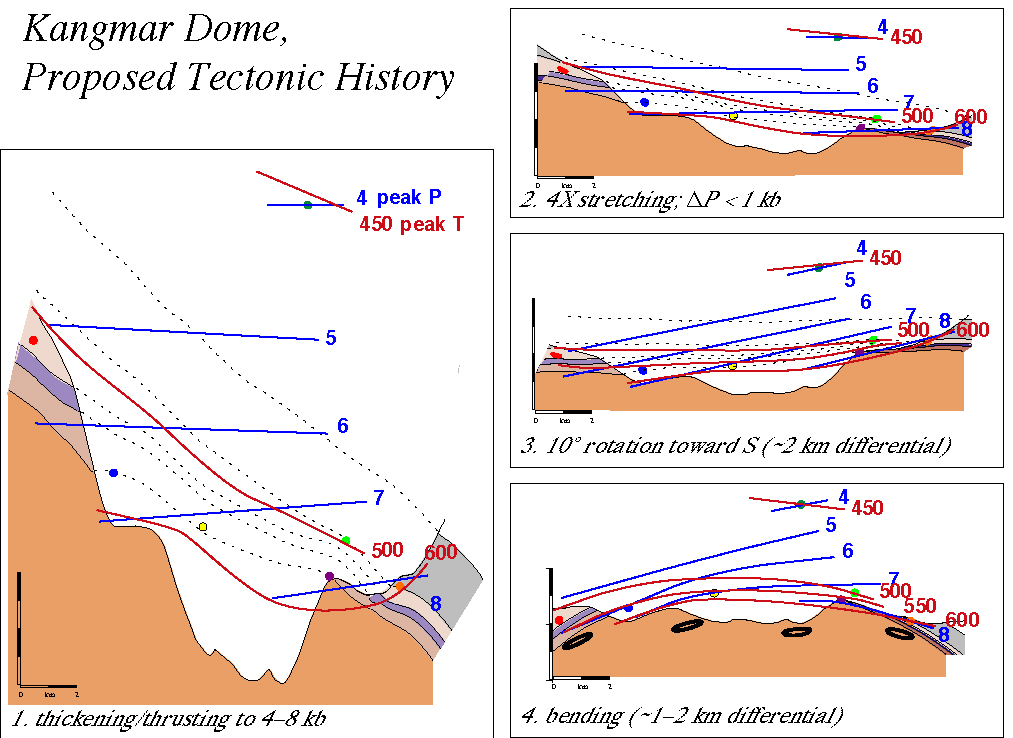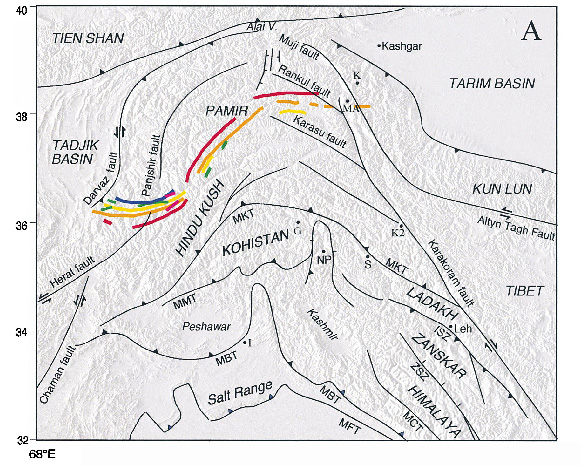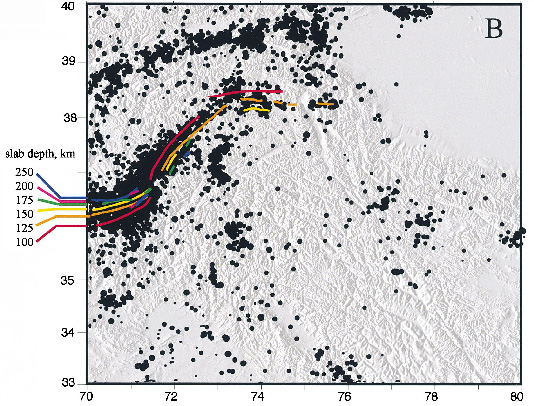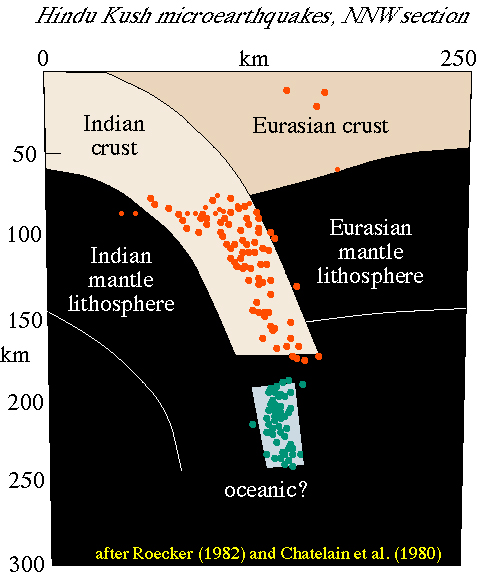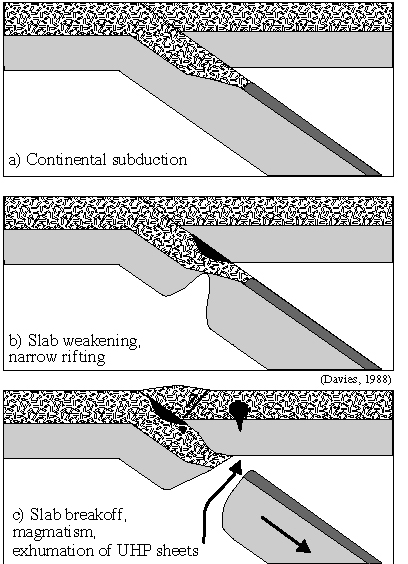 | Metamorphism and Deformation |
stable cratons (green): cratons are stable and relatively cold, with ''normal'' thermal gradients of ~20 K/km. - magmatic arcs (red-orange): magmatic arcs are sites where heat is advected to shallow levels, producing low P/T metamorphism -crustal extension (orange): crustal extension via normal faulting leads to advection of heat to shallow levels, followed by cooling to a normal thermal gradient - oceanic extension--mid-ocean ridges (red-orange): convection carries heat to very shallow levels, where 7-km thick oceanic crust forms; hydrothermal circulation produces low P/T metamorphism |
ophiolite soles (red): are thrust zones beneath very hot oceanic lithosphere emplaced onto passive continental margins; in contrast to other low P/T metamorphism, inverted metamorphic gradients form because the emplacement rate is rapid compared to the rate at which the extreme heat is conducted away |
|
subduction zones (blue): rapid subduction advects cold material into the mantle, producing high P/T metamorphism |
continent-continent collisions: rapid crustal thickening produces high temperatures at moderate temperatures, followed by cooling |
|
ultrahigh-pressure metamorphism: small pieces of continental material subducted to as much as 200 km are eventually regurgitated, leading to ultrahigh P/T metamorphism |
Contact Methamorphism |
discernible in the decussate texture of this metavolcanic wall rock |
Regional contact metamorphism is caused by pluton intrusion and cooling over a large area. Shown here is Cretaceous plutonism and cooling from the Dabie Shan of China |
The shallowest levels of ocean crust are only weakly metamorphosed to zeolite facies |
The hallmark of magmatic extension is sheeted dikes, which are usually partially altered to greenschist facies -sheeted |
The underlying gabbros are heterogeneously altered, mostly around hydrothermal circulation zones - layered gabbro |
"Tethyan-type" ophiolites are emplaced onto passive continental margins by subduction of the continental margin beneath an intraoceanic, immature arc |
Specifically, intraoceanic thrusting may begin along transform faults where young and old lithosphere are juxtaposed |
This process leads to the formation of a metamorphic sole with an inverted metamorphic gradient |
U/Pb zircon and 40Ar/39Ar dating shows that the intraoceanic thrusting took <2 Myr |
Leading to a cooling history that is very rapid (and very similar) in both the oceanic crust and the metamorphic sole |
The continental margin rocks record high pressures and the ophiolite sole shows high temperatures that are easily modeled as the result of emplacement of very young (<2 Myr old) lithosphere. The continental margin underwent deep burial and minor heating followed by cooling and decompression, whereas the metamorphic sole underwent substantial heating and minor compression and then cooling and decompression P-T diagram |
Subduction zone: Blueschist-facies rocks are often incompletely reacted to the high-pressure assemblage, leading to variable preservation of igneous textures and/or minerals, as exhibited by this outcrop from the Klamath Mountains |
Subduction zone: Eclogites in many locations occur as blocks within a more felsic matrix |
Subduction zone: The host gneiss is usually, after considerably more searching, also found to contain evidence of high-pressure metamorphism. Other localities, such as Oman, however, contain extensive intact tracts of high-pressure rocks |
Subduction zone:This eclogite from Dabie Shan China contains abundant phengite, the Mg+Fe+Si-rich form of muscovite. The eclogite at Verpeneset, Norway, contains Na-pyroxene + garnet (which define an eclogite), plus rutile, kyanite, and zoisite |
"Warm" subduction zones--a result of slow subduction and/or young subducted lithosphere and "cold" subduction zones-- a result of rapid subduction and/or old subducted lithosphere, have different thermal regimes, dehydration depths, mantle wedge temperatures and circulation, and styles of volcanism |
Collision "continent-continent" |
Collision "continent-continent'' |
Deep-level constraints on the present-day structure of the orogen are provided chiefly through seismic reflection and refraction data |
the southern margin of the Plateau is underlain by India and the northern margin of the Plateau is underlain by Asia. |
The present-day high (5 km) elevation of the plateau is believed to be related to large-scale crustal thickening, combined with delamination of the mantle lithosphere and asthenosphere reaching to unusually shallow levels |
The thermal evolution during continental thickening can be modeled with a 1-D "sawtooth" thermal gradient, and attains high temperatures largely through the extreme thickness of radiogenic material |
Continental thickening can lead to interesting kinds of melts and residuum that subsequently influence the deformation and evolution of the orogen |
An example of the texture produced by such melting |
An example of the texture produced by such melting -gneiss dike |
Typical Barrovian continental metamorphism is Kangmar Dome in southern Tibet |
Kangmar P-T - The calculated P-T conditions/paths of various samples indicate a large range of pressures from ~3 to 8 kbar, but a modest range in temperature from ~400 to 600�C |
This group of P-T paths can be explained as part of what one would expect from the kind of burial and heating characteristic of Barrovian metamorphism |
Here are the calculated P-T conditions of samples shown in the cross section Kangmar |
The P-T conditions of the samples constrains a surprisingly complicated tectonic history |
A modern analog for UHPM is the Hindu Kush mountain range of central Asia |
earthquakes down to depths of xxx km in material that has seismic wave speeds consistent with continental crust |
Cross Section |
|
These subducted continental rocks are exhumed through the mantle following tearing of the slab (called "slab breakoff") |
Source: http://www.geol.ucsb.edu/faculty/hacker/geo102C/lectures/part1.html
http://www.geol.ucsb.edu/faculty/hacker/geo102C/lectures/part13.html
http://www.geol.ucsb.edu/faculty/hacker/geo102C/lectures/part14.html
stable cratons (green): cratons are stable and relatively cold, with ''normal'' thermal gradients of ~20 K/km. In detail, this simplification is incorrect. Continental rocks usually begin life somewhat hotter than this as a result of crustal stacking and radiogenic heat generation, but then cool over time.
Magmatic Arcs
Magmatic arcs (red-orange) are sites where heat is advected to shallow levels, producing low P/T metamorphism. The heat is chiefly provided by silicate melts derived from melting of the upper mantle. Contact metamorphism is common in such settings. Good examples of this include the Sierra Nevada and Klamath Mountains.
Oceanic Extension
During extension at mid-ocean ridges (red-orange), convection carries heat to very shallow levels, where 7-km thick oceanic crust forms; hydrothermal circulation produces low P/T metamorphism, often called seafloor metamorphism:
Many good examples of seafloor metamorphism are known from ophiolites in the Sierra Nevada and Klamaths.
Ophiolite Soles
Ophiolite soles (red) form in thrust zones beneath very hot oceanic lithosphere emplaced onto passive continental margins. In contrast to other low P/T metamorphism, inverted metamorphic gradients form because the emplacement rate is rapid compared to the rate at which the extreme heat is conducted away.
Subduction Zones
Rapid subduction advects cold material into the mantle, producing high P/T metamorphism (blue), sometimes called "Franciscan-type" or "Sambagawa-type" in reference to two classic examples in California and Japan. The "coldness" of the subduction zone depends on the age of the plate (older = colder) and the rate of subduction (faster = colder). Eclogites are the signature rocks of this process.
The signature rocks of high-pressure metamorphism and blueschists and eclogites.
Recall that the characteristic diffusion distance for a thermal pulse to move over a 1 Ma time frame is ~5 km. This is an average movement rate of 5 km/Ma. Thus, a steady state thermal regime cannot be disturbed by advection that is slower than this, because the thermal diffusion is able to "iron out" the effects of diffusion. If, however, the advection rate is faster, the thermal regime will be disturbed, and, in the case of subduction zones, will lead to an inverted thermal gradient. This ratio between the effects of conduction and advection is called the Peclet number.
The subducted crust and mantle contains a heterogeneous distribution of hydrous metamorphic minerals. These minerals break down during subduction, producing fluids that reach the mantle wedge and cause melting of the mantle peridotite (the introduction of H2O lower the solidus)
Continent-Continent Collisions
Rapid crustal thickening during continental collisions produces high temperatures because of the large amount of radiogenic elements in continental crust. The pressures are moderate because continental crust is never thicker than ~75 km (2.5 GPa). These abnormally high temperatures are followed by cooling to a normal cratonal geotherm. This is the cause of so-called "Barrovian" metamorphism, signature minerals of which are staurolite + kyanite. Good examples are known from the Tibet and Himalaya.
A geological map of the central Himalaya shows the crystalline rocks of the Indian crust (Subhimalayan sequence), passive margin sediments of the Indian plate (Lesser Himalayan sequence), crystalline rocks of the Tibetan crust (High Himalayan Crystallines), passive margin sediments of the Tibetan crust (Tethyan Himalaya), and pre-collisional Gangdise Batholith.
